The camp is nestled in a valley of the coastal range in a beautiful grove of Redwood trees.
As we head down Highway 12 into the Napa Valley the Marine Layer of cold moist air encases the hilltops in a shroud of low clouds. Entering the valley is like taking a step back in time. Life seems simpler, less hectic, troubles seem to melt away.
[click photos to enlarge]

The giant wine press guy works diligently, oblivious to the traffic, at the entrance to Napa Valley Wine Country.

This detail and the following one are from a previous trip to Napa last March.


Descending from the Highway 12 Napa River bridge, a left turn at the gap in the Eucalyptus trees heads us toward the coast.

The vineyards cover the hills to the horizon and beyond.

A vintner's estate - one of several along the way.

One of many scenic spots along the way.

An old farmstead along the way.

Some times the road seems to launch into space...

Or into the clouds.

The rolling hills southeast of Petaluma.
That yellow directional sign between the three power poles is also on our road.

A beautiful pastoral setting enhanced by the fog.

Heading north on Highway 101 it's a short hop from Petaluma to our turnoff at Cotati.

One last hill to climb before we leave the highway for the steep winding roads through the coastal mountains and valleys. We're getting close and the anticipation is growing.

In the town of Graton migrant workers line up for day work at the vineyards and other agricultural endeavors in the area.

The Bohemian Highway winds through dense forests as it follows Dutch Bill Creek.
My daughter's camp is just ahead.

Having dropped her off I now have eight hours to myself - time to explore. My first stop will be Monte Rio on the Russian River.
The the Russian River bridge at Monte Rio.


Although it appears to be a lazy little river, the Russian river can in fact turn into a monster in a matter of hours when heavy winter rains fall over the coastal mountains and valleys.
 [Photo Credit: Russian River Historical Society]
[Photo Credit: Russian River Historical Society]A few artsy-fartsy things.

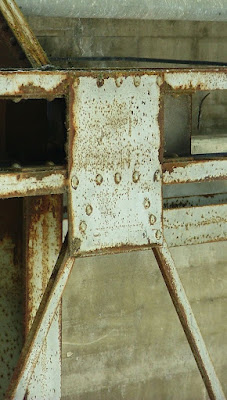

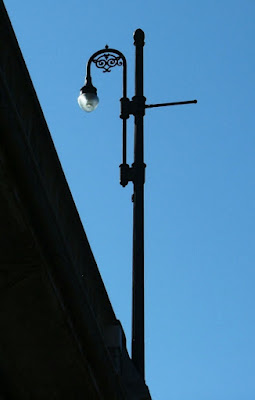
A plant grows from a crack in the bridge footing.

A hotel, tucked into the hillside, overlooks the river.

I want this yellow house!

A lone kayaker enjoys the early morning tranquility.

Canoes and kayaks await the crowds.
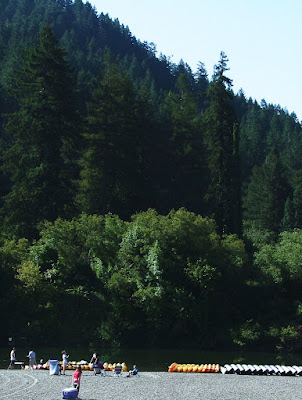


The Russian river widens...

As it winds to the ocean just beyond the distant hills

At last, the Pacific Ocean...

And the Sonoma Coast.

Goat Rock. My wife's brothers once challenged each other to climb to the top.
Coming back down was another matter. They had to be rescued.

The hillsides rise abruptly from the ocean along the Sonoma Coast.


The restroom building at Goat Rock is dwarfed by a rock outcropping.

Looking over one of those precipitous cliffs. That bump on the edge of the cliff's shadow - just to the left of the high point in the middle - is my shadow.

Wildflowers abound. To survive the driving winds they grow low to the ground in a tightly matted community of various plant species.







Bees were also in abundance.

If cars could fly!

Some other views of the Sonoma Coast near Jenner.
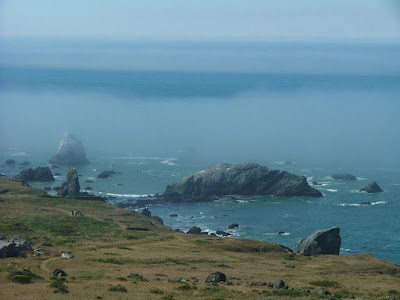





The river - visible on the far right at the foot of the hills - is blocked by a sand bar at low tide.

The town of Jenner hangs on the hillside above the Russian River near its mouth.

Jenner
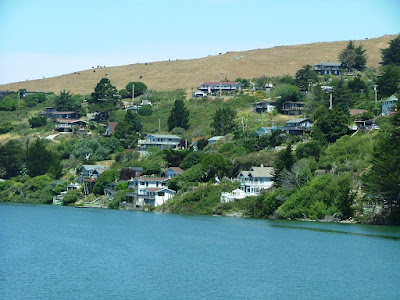
A fog bank rolls in adding an air of mystery.


The weather couldn't have been better. Seventy-three degrees with a light wind and gentle surf. I've been here before when it was about sixty-two with fifty mile per hour winds and thirty foot swells which is more typical of summer time when the interior valley is in the one hundreds.


Like so many logs, sea lions line the beach of the Russian River where it meets the sea.

Bring a helicopter if you want to collect driftwood here. (For size reference click to enlarge and you will find a person sitting on the rock just to the right of farthest log.


A gull waits for a morsel to wash up on the surf.

Does it bite?

Many interesting shapes, colors and textures can be found in the flotsam left at low tide.









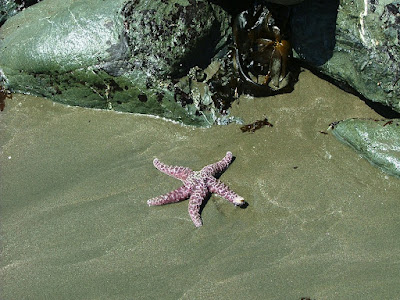

This gull waited patiently for me to slip and slide over the seaweed covered rocks to take his picture. In fact he gave me several poses with this the best.

Leaving the ocean behind I head back inland several miles to Pomo Canyon.
At the bottom of the canyon is Willow Creek, one of the last tributaries to the Russian River before it reaches the ocean.

Upstream Willow Creek disappears into the distant hills.

A thin veil of smoke hangs in the air, encroaching from the fires near Big Sur, some 150 miles to the south.

Downstream the hills taper off until they drop to the Russian River.

An old barn along the road yields a number of possibilities.

Standing strong against the ravages of time.

Most likely it was majestic in its day, with many head of cattle lined up at the feed trough.

One of my favorite subjects - old rusty things.

I can't imagine what this was for.

A door, still in its frame, angles as in a whimsical playhouse.

Other sheds on the property were too overgrown to access.

Next my journey took me to the Armstrong Redwoods 2 miles north of Guerneville.
Here, with the forest canopy reflected in its glass cover, is a brief history of the Redwoods with a plea to help preserve them.
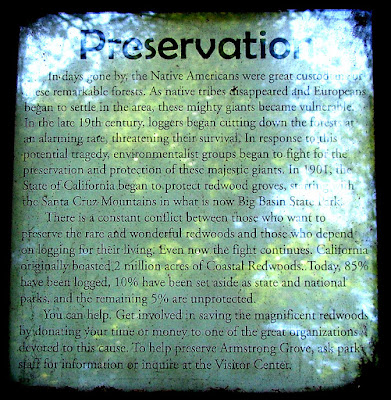
Relatively young Redwoods dwarf the ranger station and cars in the parking lot.


Several photos with hikers to give an idea of scale.


A car squeezes between several trees.

Nighttime fog condenses on the trees and drips to the floor providing for lush growths of moss and ferns.



With the lowest branches 100 feet or more above the forest floor the Redwoods soar to dizzying heights.




Several spots along the trail amidst some of the larger trees.

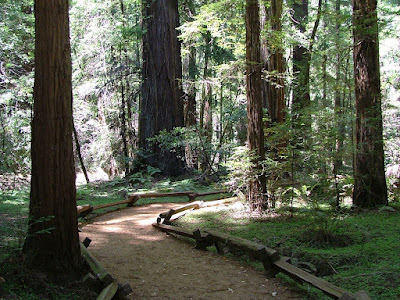
A wheelchair path wraps around the trunk of a large Redwood.
This particular trail features a guide rope along one side and plaques in braille for the visually impaired.

A dry creek bed turns into a salmon breeding habitat in the spring.

A couple walks amidst a young grove of Redwoods.
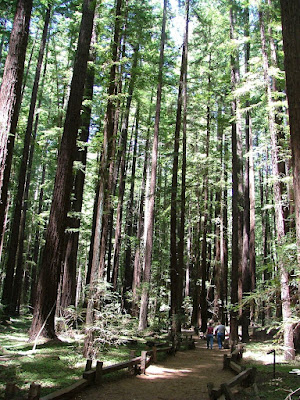
One survival scheme of the Redwood tree is to produce multiple trunks from the same root stock. The younger shoots eventually replacing the older trunks.

A young shoot sprouts at the base of a large tree.

Here is an example of the Redwood's ability to survive fires. A large burn scar is in the process of being healed.

If only we could find a commercial use this plant we could solve the California fiscal crisis. Prolific throughout the lower elevations Poison Oak flourishes in most environments. Contact with the plant can causes blistering, itching rashes which can become significant in sensitive people. It is however quite photogenic.



Poison Oak can take on many forms, from a low ground cover to tree-like shrubs. Here in its vine form it climbs to 60 feet or more up the trunk of a Redwood.

The tallest tree in the grove is the Colonel Armstrong. This sign gives the details.

Colonel Armstrong tree - this photo took 3 seperate images merged together to capture the whole tree.

Leaving the coast and forest behind we get several last looks at the vineyards stretching to the horizon.


A vintner's estate glows in the blush of the late day sun.

Shadows from the setting sun accentuate the textures of the rolling hills.

The Hwy 12 bridge over the Napa River return's us to a more hectic world.

With the setting sun behind us, one of Sacramento's high rises glows pink in the distance. (Bumpy road blurring.)

The Sacramento skyline signals an end to the journey.
 [All photos by Bluebear2 except where noted]
[All photos by Bluebear2 except where noted]




No comments :
Post a Comment